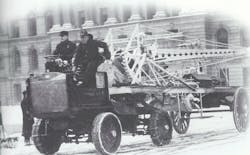JERSEY CITY, NJ: FEB. 2, 1911 – Minutes after noon, 30 men were killed and hundreds were injured when 50,000 pounds of dynamite being offloaded from a railroad freight car onto a lighter (a flat-bottom open boat or barge) docked at Pier 7 exploded. The powerful blast destroyed the pier, two lighters and three ferries and badly damaged the railroad terminal. It was estimated the shock wave shattered more than 100,000 windows in Jersey City, Ellis Island, Staten Island, Manhattan and Brooklyn.
WEEHAWKEN, NJ: FEB. 6, 1911 – Another major emergency occurred along the Jersey waterfront when a major fire broke out in the coal yards of the Erie Railroad. The flames broke out in an oil shed and produced thick clouds of smoke that swept across the Hudson River and blanketed Manhattan Island. Four engines from Weehawken and two from Hoboken battled the blaze with assistance of two FDNY fireboats. Fireboats, tugboats and land engines fed more than 100 hoselines simultaneously. The flames were battled for six hours before being brought under control.
BROOKLYN, NY: FEB. 12, 1911 – Five hundred women and girls were thrown into a panic when flames swept through the Burden Department Store at Broadway and Cooper Street while a “fire sale” was in progress. Flames were seen near a cash register on the second floor at 10 P.M. where damaged goods from a previous fire were being sold at discount prices. The area surrounding the register was filled with highly flammable lace curtains and other fabrics and was soon filled with flames. The calm demeanor of sales girls and several other employees helped evacuate all the shoppers without incident. Responding fire apparatus did cause a small panic to sweep through the fully occupied moving-picture theater next door. Chief Edward F. Croker responded from Manhattan and took charge of the four-alarm blaze.
SUTTON, WV: FEB. 20, 1911 – Seven people lost their lives as flames swept through a private house. The fire started in a natural gas grate and spread quickly across the first floor while the family slept in bedrooms on the floor above. Smelling smoke, the parents woke and tried to save their children. The father grabbed two children and dashed to the stairs, which immediately collapsed beneath him. The two children perished, but somehow the man survived. The mother, seeing the stairway fall, jumped from a second-floor window, but was fatally injured. Four other children also perished in the flames.
WHITE PLAINS, NY: FEB. 24, 1911 – One hundred fifty people fled from their homes and property as flames swept a block of downtown buildings. The flames broke out around 3 P.M. in the hotel formerly owned by Admiral Dot, a diminutive performer under contract with P.T. Barnum. The 25-inch-tall entrepreneur had recently sold the hotel and retired into seclusion. As the fire raged out of control and spread to nearby buildings, mutual aid from surrounding departments descended on the scene. At the height of the blaze, an explosion shook the hotel, toppling the walls onto firemen operating nearby. One member of Hope Engine Company, George Holip, was buried beneath the rubble. Under the protection of a hose stream, the trapped fireman was freed after 30 minutes of dangerous rescue work. He was rushed to the hospital with a broken leg and smoke inhalation. A civilian onlooker suffered a heart attack and died during the blaze.
PAUL HASHAGEN, a Firehouse® contributing editor, is a retired FDNY firefighter who was assigned to Rescue 1 in Manhattan. He is also an ex-chief of the Freeport, NY, Fire Department. Hashagen is the author of FDNY: The Bravest, An Illustrated History 1865-2002, the official history of the New York City Fire Department, and other fire service books. His latest novel, Fire of God, is available at dmcfirebooks.com.
Paul Hashagen
PAUL HASHAGEN, a Firehouse® contributing editor, is a retired FDNY firefighter who was assigned to Rescue 1 in Manhattan. He is also an ex-chief of the Freeport, NY, Fire Department. Hashagen is the author of FDNY: The Bravest, An Illustrated History 1865-2002, the official history of the New York City Fire Department, and other fire service books.
Connect with Paul
Website: paulhashagen.com
Facebook: Paul Hashagen-author






